St. John the Evangelist Catholic Church
816 Union Street
Schenectady, NY
OHS convention: 2006
Images
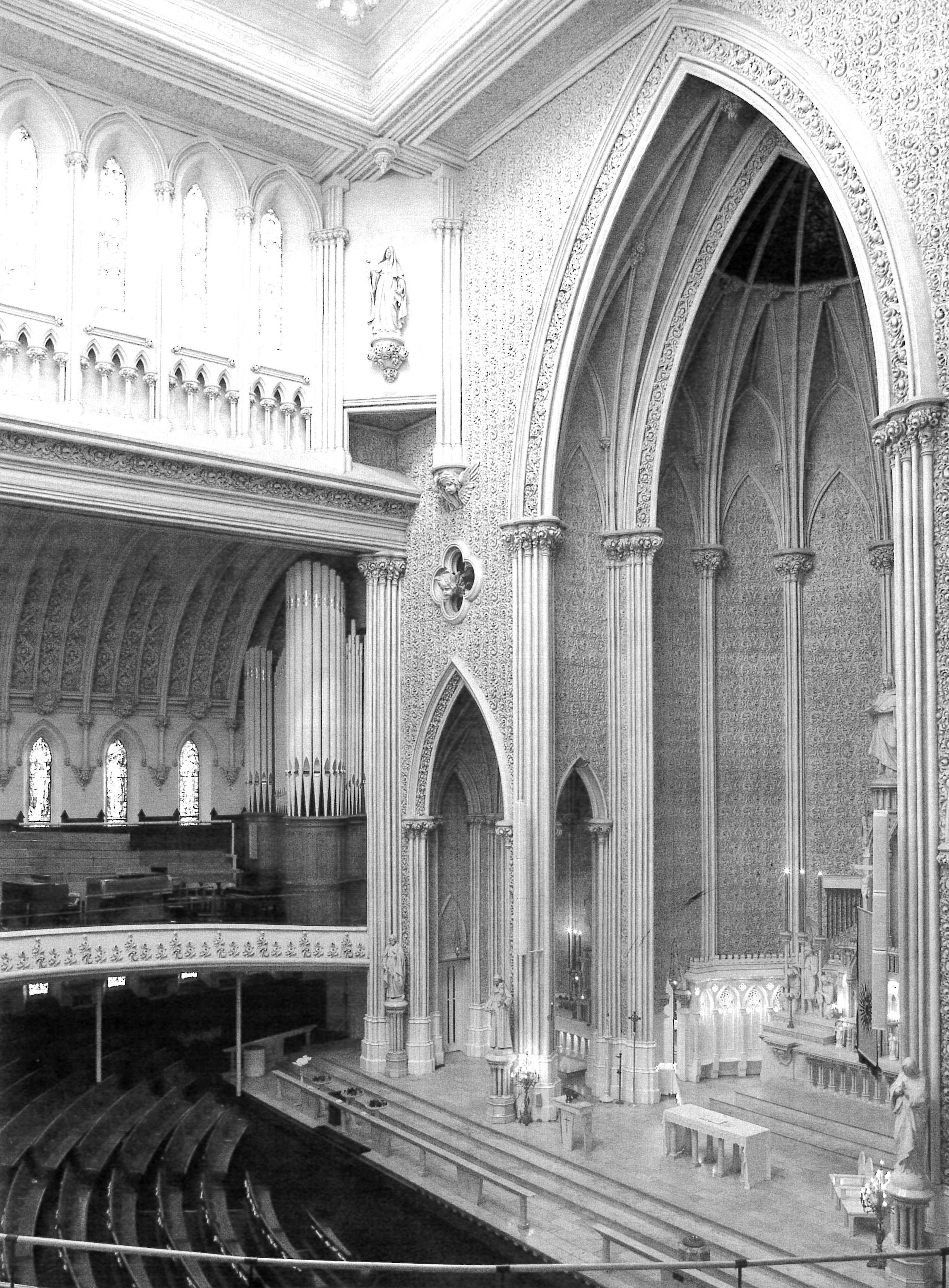 2005 - Sanctuary with organ in gallery (Photograph from an archival source: 2006 OHS Atlas, Victor Hoyt, submitted by Paul R. Marchesano/Paul R. Marchesano)
2005 - Sanctuary with organ in gallery (Photograph from an archival source: 2006 OHS Atlas, Victor Hoyt, submitted by Paul R. Marchesano/Paul R. Marchesano)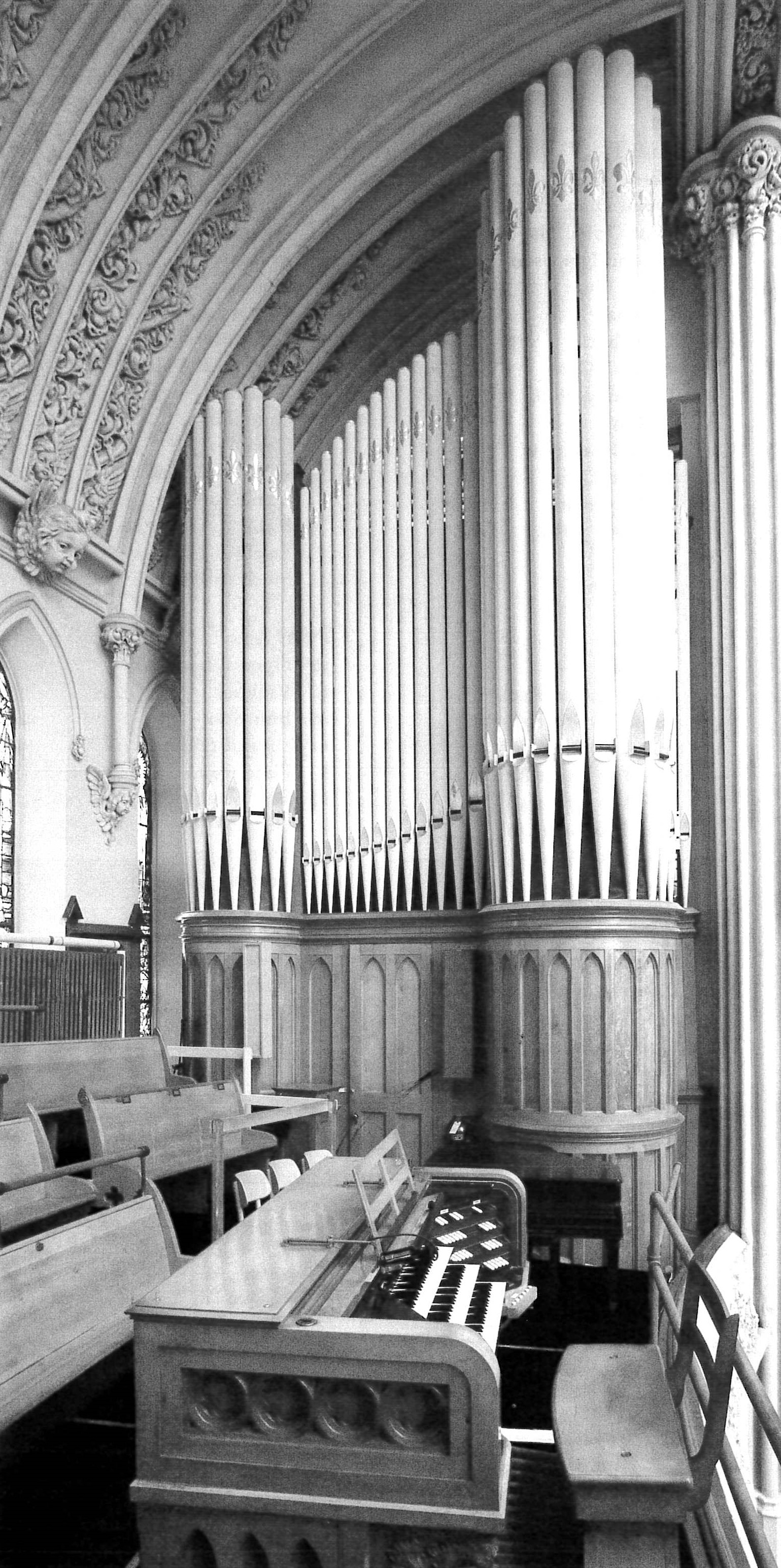 2005 - Console and facade (Photograph from an archival source: 2006 OHS Atlas, Victor Hoyt, submitted by Paul R. Marchesano/Paul R. Marchesano)
2005 - Console and facade (Photograph from an archival source: 2006 OHS Atlas, Victor Hoyt, submitted by Paul R. Marchesano/Paul R. Marchesano)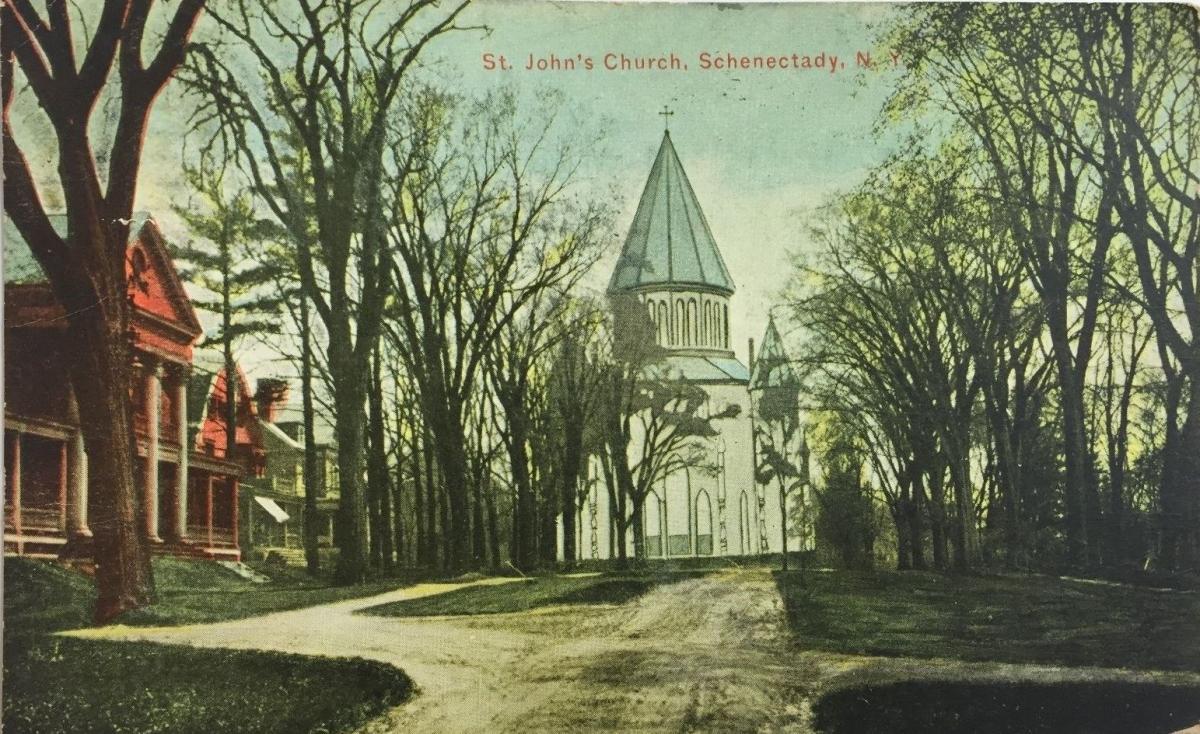 Unknown - Church Exterior (Vintage Postcard, courtesy of T. Bradford Willis, DDS (1910)/Database Manager)
Unknown - Church Exterior (Vintage Postcard, courtesy of T. Bradford Willis, DDS (1910)/Database Manager)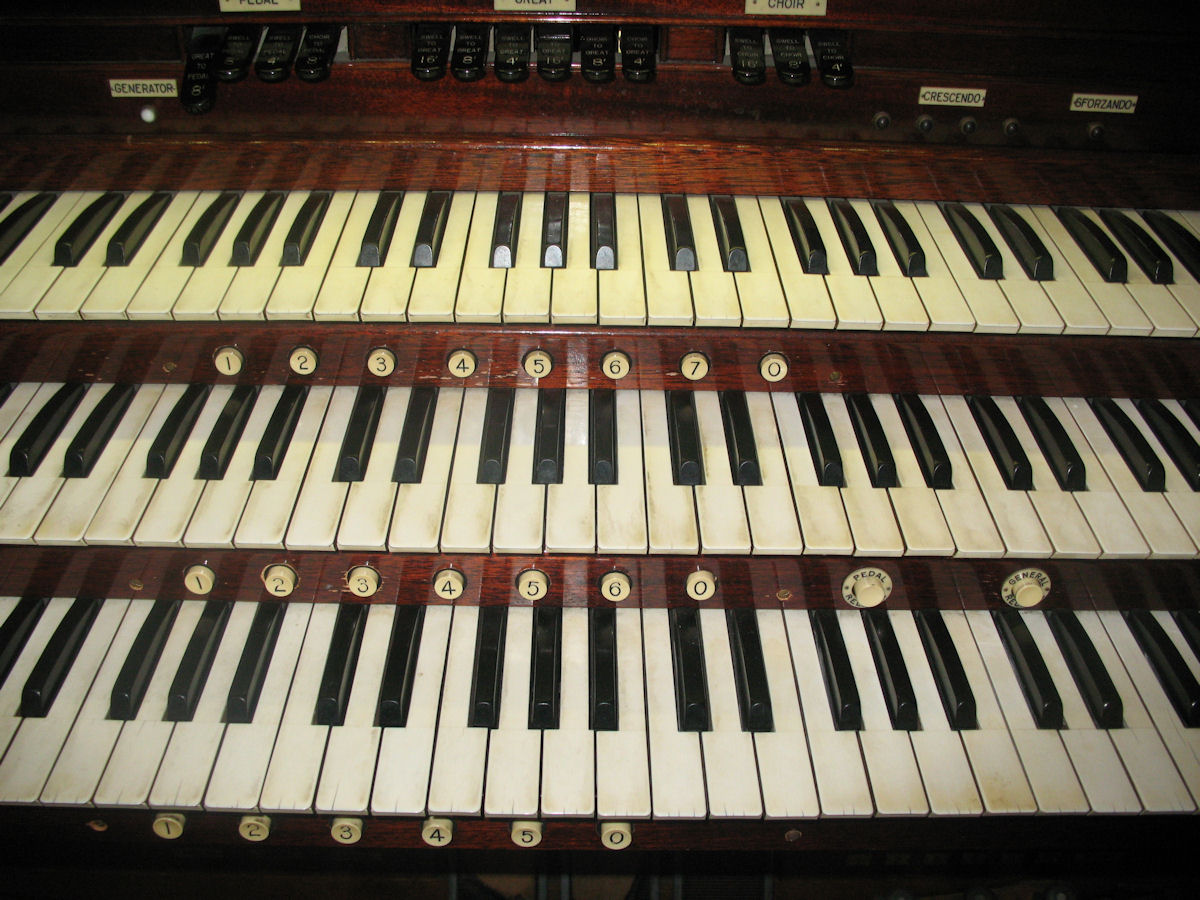 2006-12-30 - Manual keyboards (Photo by Brendan Moore/Database Manager)
2006-12-30 - Manual keyboards (Photo by Brendan Moore/Database Manager)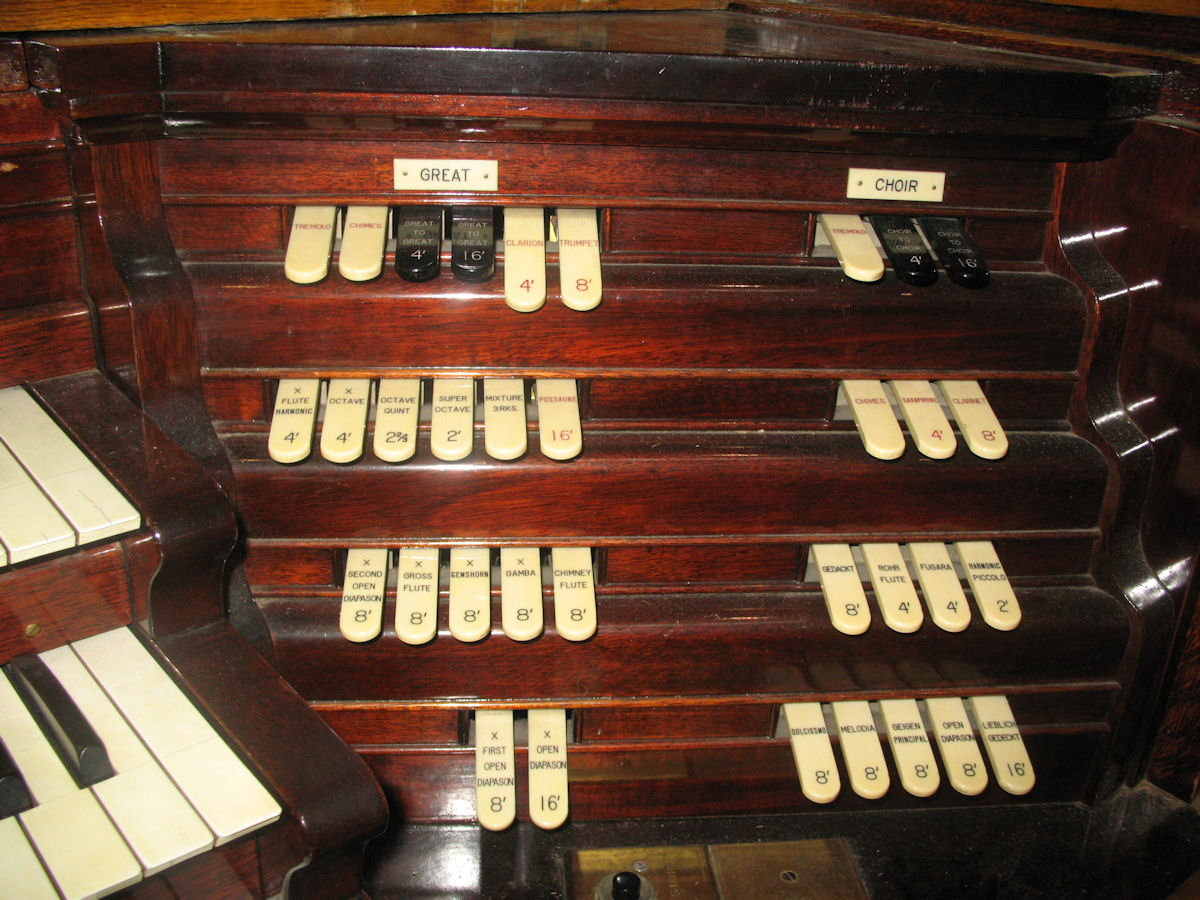 2006-12-30 - Right stop jamb (Photo by Brendan Moore/Database Manager)
2006-12-30 - Right stop jamb (Photo by Brendan Moore/Database Manager)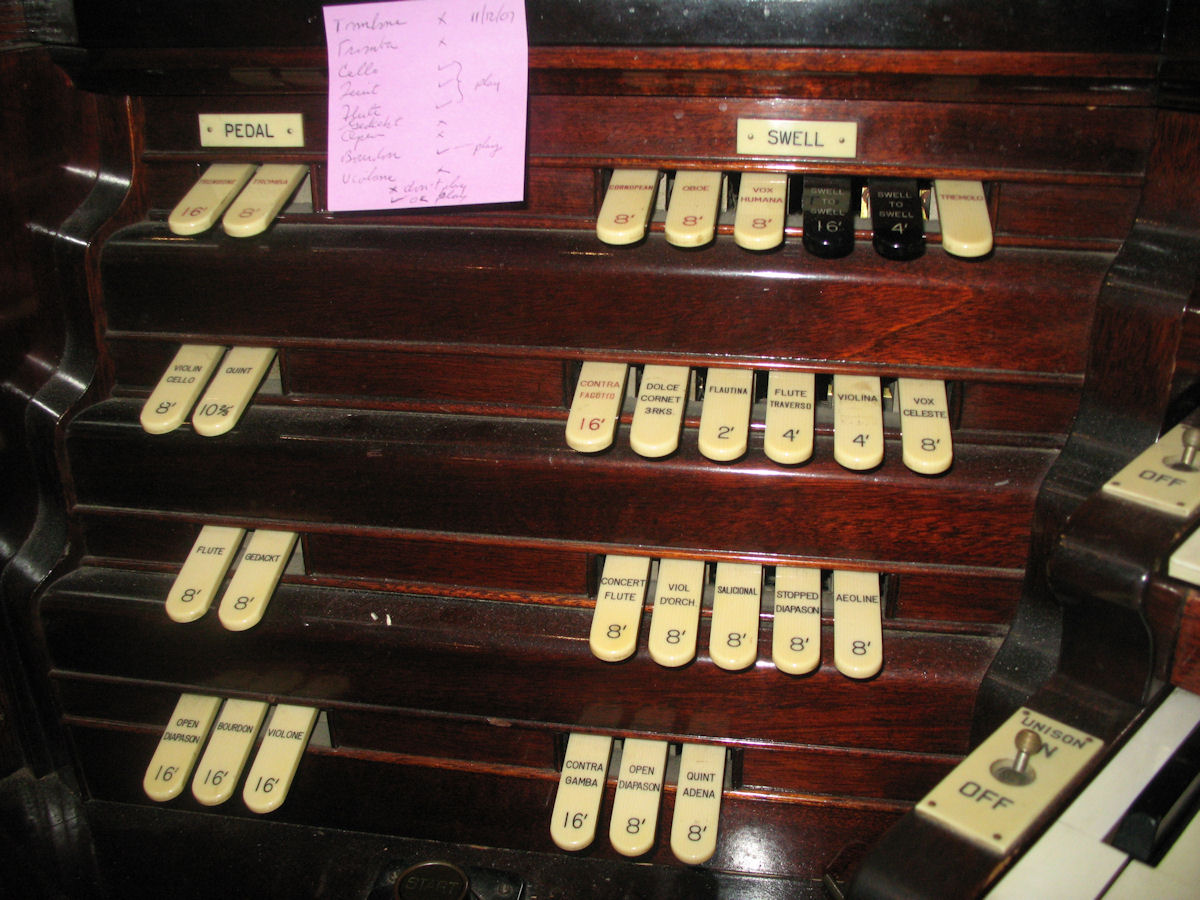 2006-12-30 - Left stop jamb (Photo by Brendan Moore/Database Manager)
2006-12-30 - Left stop jamb (Photo by Brendan Moore/Database Manager)
Consoles
Main
- Organ type: Traditional With Roll Top
- 3 manuals
- 48 stops
- 64 registers
- Key action Type: Electrical
- Stop action Type: Electrical
- Stop layout Type: Stop Keys on Angled Jambs
- Manual compass: 61 notes
- Pedal compass: 32 notes
- Pedal Type: Concave Radiating (Details Unknown)
- Expression Type: Balanced Expression Shoes/Pedals (Meeting AGO Standards)
- Has crescendo
- Has combination thumb pistons
- Has combination toe pistons
- Has tutti thumb pistons
- Has tutti toe pistons
Notes
2004-10-30 - New Console, 1934 -Database Manager
2006-06-15 - OHS 2006 -Database Manager
2008-01-21 - Updated through online information from Brendan Moore. -- The organ is located on the left side of the circular balcony of the church. While the Diapasons and Flutes are big and bold, the reeds are set far in the chamber, making them difficult to hear. Also, as of 2008, the organ is playable, but there are some dead notes and the 8' Vox Humana is not working. (On an interesting note, the Vox Humana has a separate tremolo that activates when the stop key is depressed) -Database Manager
2021-09-26 - The present stop tab console is by the Utica organbuilder Buhl, inside the oak casing of the original Hutchings drawknob console. It contains couplers and accessories not present on the original, including a pneumatic combination action adjustable at the keydesk, replacing the original blind Hutchings combinations by setterboard.
The pedal Trombone is the only high-pressure stop in the organ, operating off blower static pressure, approx. 7"-8" wp. The original windchests are still in place, utilizing Hutchings side-bar pitman action. Each division has its own single-rise sprung regulator, and the blower feeds a sprung static reservoir. The facade pipes play off their own offset actions rather than being tubed from the main windchest. -Scot Huntington
Stoplist
Typed stoplist from the OHS PC Database. Source: Source not recorded Date not recorded
St. John the Evangelist, R. C., Schenectady, NY
1904 Hutchings-Votey
(Stoplist: Agnes Armstrong 1998)
GREAT:
16' open diapason
8' first open diapason
8' second open diapason
8' gross flute
8' gemshorm
8' gamba
8' chimney flute
4' octave
4' flute harmonique
2 2/3' octave quint
2' super octave
III mixture
16' posaune
8' trumpet
4' clarion
SWELL:
16' contra gamba
8' open diapason
8' quintadena
8' concert flute
8' viol d'orchestra
8' salicional
8' vox celeste
8' aeoline
8' stopped diapason
4' violina
4' flute traverso
2' flautina
III dolce cornet
16' contra fagott
8' cornopean
8' oboe
8' vox humana (has its own tremolo)
tremolo
CHOIR:
16' lieblich gedeckt
8' open diapason
8' geigen diapason
8' melodia
8' dolcissimo
8' gedeckt
4' fugara
4' rohr flute
2' harmonic piccolo
8' clarinet
4' saxophone
chimes
tremolo
PEDAL:
16' open diapason
16' bourdon
16' violone
8' flute (extension)
8' gedeckt (extension)
8' violoncello
10 2/3 quint (extension)
16' trombone
8' tromba
The organ is playable, but in an accelerating state of deterioration due to its
age. Up until World War II, it was used regularly, but after the war, it was
reported that the organ had become "unplayable" - in fact, as was
discovered in the early 1970s, the old blower motor was simply incompatible with
the (presumably changed) municipal electrical current. Schenectady being the
home of Steinmetz and birthplace of the General Electric Corporation, the place
abounds with retired electrical engineers, and some of them were able to
re-phase the motor. Lo and behold! the organ played again. Perhaps it is this
ignorance and disinterest that managed to save this organ, for instead of
solving the original problem, the congregation brought in a big Allen and placed
it right next to the Hutchings console. I am told that there are times when
both instruments are used together (gasp)!
Since the 1970s maintenance work has been carried on largely by volunteers
connected with the local chapter of the Theatre Organ Society, who also look
after "Goldie" - the big Wurlitzer at Schenectady's Proctor's Theatre.
Sometime in the 1930s, the Hutchings-Votey's console innards were rebuilt using
parts from Erie and Hagerstown companies. These replacement parts are in very
poor shape. Presently, releathering is carried on "as needed", which is to say
that in Guilmant's "Marche funebre et chant seraphique" when I play the 12-bar
low pedal trill against large chords on the full organ, the poor old thing gasps
as though being strangled.
The sounds of the organ are/could be impressive, if one appreciates them in the
context of their time. Certainly the Vox Humana is one of the most delightful
examples of the Late Romantic style that I have ever encountered.
The foundations are round, the flutes and strings are lush. The upperwork is
lightweight, and the organ rumbles more than it screams, which is just right for
the repertoire I prefer to play. The organ is chambered in a corner
of the balcony, and the organist sits sidewise to the installation, which is odd
at best - only the organist's right ear hears the full sound. And many of the
pipes are so far away as to create multiple, unsolvable delay problems.
Still, this is surely an organ worthy of being played, worthy of being heard,
and certainly worthy of a full restoration.
Agnes Armstrong
Pages 65-68 Source: OHS Organ Atlas of the Capital District Region 2006 2006
Schenectady, New York
St. John the Evangelist Roman Catholic Church
Hutchings-Votey Organ Co. Opus 1510 1904 3 manuals, 48 stops, 52 ranks
Buhl stop tab keydesk: reeds printed in red, coupler tabs are black
Compasses:61/32 (originally 30, top two notes play couplers only)
____________________________________________________________________________
GREAT ORGAN SWELL ORGAN
16' Open Diapason 61 16' Contra Gamba 61
8' First Open Diapason 61 8' Open Diapason 61
8' Second Open Diapason 61 8' Concert Flute 61
8' Gross Flute 61 8' Stopped Diapason 61
8' Gamba 61 8' Viol d'Orch. 61
8' Gemshorn 61 8' Vox Celeste (TC) 49
Enclosed with Choir: 8' Salicional 61
8' Chimney Flute* 61 8' Quintadena 61
4' Octave 61 8' Aeoline 61
4' Flute Harmonic 61 4' Flute Traverso 61
2 2/3' Octave Quint 61 4' Violina 61
2' Super Octave 61 2' Flautino 61
Mixture 3 Rks. 183 Dolce Cornet 3 Rks. 183
16' Posaune 61 16' Contra Fagotto 61
8' Trumpet 61 8' Cornopean 61
4' Clarion 61 8' Oboe 61
Tremolo 8' Vox Humana (+tremolo) 61
Chimes Tremolo
16' Great to Great 16' Swell to Swell
4' Great to Great 4' Swell to Swell
* later addition on separate chest
CHOIR ORGAN PEDAL ORGAN
16' Lieblich Gedackt 61 16' Open Diapason 42
8' Open Diapason 61 16' Violone 42
8' Geigen Principal 61 16' Bourdon 42
8' Melodia 61 10 2/3' Quint (Bourdon) --
8' Gedackt 61 8' Flute (Open Diap) --
8' Dolcissimo 61 8' Violoncello (Violone) --
4' Fugara 61 8' Gedackt (Bourdon) --
4' Rohr Flute 61 16' Trombone 42
2' Harmonic Piccolo 61 8' Tromba (Trombone) --
8' Clarinet 61 Chimes (Gt)
4' Saxophone 61
Tremolo
16' Choir to Choir
4' Choir to Choir
COMBINATIONS BALANCED PEDALS
Great & Pedal 0-6 (thumb) Choir
Swell & Pedal 0-7 (thumb) Swell
Choir & Pedal 0-5 (thumb) Crescendo (4 ind. lights)
General 1-6 (thumb & toe)
General Release (thumb) ACCESSORIES
Pedal Release (toe) Tower Chimes on-off (switch)
Master Setter Maas-Rowe chime dial
Gr. to Ped. Rev. (toe) Generator indicator light
Swell to Ped. Rev. (toe) Swing-away chime keyboard
Ch. to Ped. Rev. (toe) (c13-c37, 25 notes)
Sforzando (toe) Sforz indicator light
COUPLERS (on back rail)
Swell to Great 16', 8', 4'
Choir to Great 16', 8', 4'
Swell to Choir 16', 8', 4'
Great to Pedal 8'
Swell to Pedal 8'
Swell to Pedal 4'
Choir to Pedal 8'
Unison Off toggle switches [on/off] on left keycheeks:
Great, Swell, Choir
COMPOSITIONS
Great: Mixture Notes Swell: Dolce Cornet Notes
2 1 1/3 1 1-24 1 3/5 1 1/3 1 1-24
2 2/3 2 1 1/3 25-36 2 2/3 2 1 3/5 25-61
4 2 2/3 2 37-61
[Received from Steven E. Lawson 2018-05-03]
Other Links
Regrettably, it is not possible to display the information about the sponsor of this pipeorgandatabase entry or if there is a sponsor. Please see About Sponsors on Pipe Organ Database.





